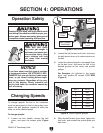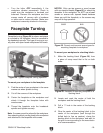
G0624 10" Benchtop Lathe
-19-
Figure 24. Typical faceplate turning operation.
Faceplate turning (Figure 24) is when a workpiece
is mounted to the faceplate, which is mounted to
the headstock spindle. This type of turning is usu-
ally done with open-faced workpieces like bowls.
Faceplate Turning
To mount your workpiece to the faceplate:
1. Find the center of your workpiece in the same
manner as when spindle turning.
2. Cut off the corners of the workpiece.
3. Center the faceplate on the workpiece and
attach it through the faceplate holes with
wood screws.
4. Thread the faceplate onto the headstock
spindle and tighten securely.
Note
: If screws cannot be placed in the workpiece,
then a backing block can be glued to the workpiece
and attached to the faceplate with screws.
Figure 26. Example of mounting faceplate to a
backing block
.
NOTICE: Only use tap screws or wood screws
with non-tapered heads
(Figure 25) to attach the
faceplate to the workpiece. Do NOT use drywall
screws or screws with tapered heads because
these can split the faceplate, or the screws may
snap off during operation.
Backing
Block
2. Locate and mark the center of both the
workpiece and the backing block.
3. Drill a
1
⁄4" hole in the center of the backing
block.
4. Glue the center of the backing block to the
center of the workpiece (look through the
drilled hole to line up centers), clamp the
backing block to the workpiece, and wait for
the glue to cure according to the manufactur-
er’s recommendation.
• Turn the lathe OFF immediately if the
workpiece vibrates excessively. Check to
make sure the workpiece is centered and
balanced. Remove the workpiece and trim
excess waste off corners with a bandsaw
or table saw to reduce vibrat
ion. Make sure
workpiece is securely attached in the setup.
To mount your workpiece to a backing block:
1. Make the backing block (Figure 26) from
a piece of scrap wood that is flat on both
sides.
Figure 25. Correct and incorrect screw types for
mounting faceplate to workpiece.


















